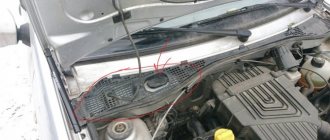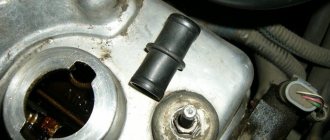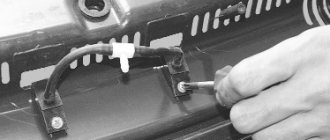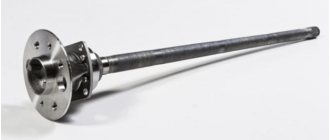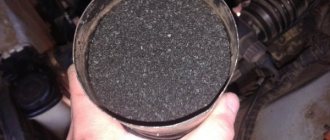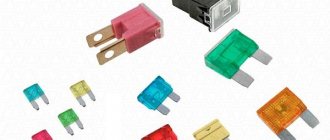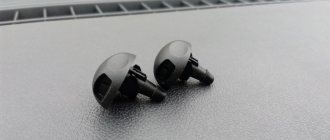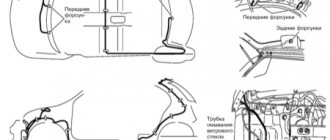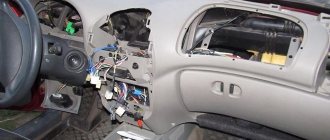A glass washer is a useful invention that was invented to make life easier for us motorists.
When the washer is working, we don’t notice it and take it for granted, but as soon as it fails, we immediately remember it and its invaluable function, without which driving seems impossible. This is true, you get used to everything good quickly, the same with the washer, once there was no glass washer or headlight washer, and everyone was happy with everything and it seemed that the car had everything that was needed. Today I propose to talk about the windshield washer and its malfunctions. You will learn why the windshield washer does not work, the reasons for its malfunction and where to look for them.
Windshield washer malfunctions can be divided into two categories - electrical and mechanical. Mechanical ones are more common, but they are usually not very difficult, so they are easier to fix than electrical ones.
So, one fine day you sit behind the wheel, decide to wash the glass, press the button and... nothing happens, no fluid flows, the glass does not wash. What's the matter? This is the first question that comes to mind after a series of obscene expressions :-))).
So why isn't the washer working? common causes
- Washer fluid level. In this case, everything is quite simple, we check the level of washer fluid in the tank, and then add it to the level if it is low, or continue to look for the problem.
- The washer was frozen. With the arrival of cold weather, many people forget to replace the washer fluid, as a result of which it simply freezes in the tank. As a result, when you try to clean the windshield, nothing happens, the engine hums, and no fluid flows. In this situation, all the blame falls on you, since you did not timely replace the summer fluid with the winter one. You can correct the situation by heating it, or by adding 200 grams of alcohol or a special defroster to the tank.
- Hoses. Damage to the fluid supply hoses or a simple hose slipping off the fitting may result in the washer not being supplied when pressed. You can check what's wrong by looking under the hood or driving into the inspection hole. If the hose is damaged it should be replaced, I guess that makes sense!?
- Injectors. No, we are not talking about fuel injectors, but about those that spray washer onto the glass. Sometimes the washer nozzles become clogged or freeze, after which the operation of the system may be disrupted. It is quite simple to check whether the injectors are to blame for the fact that the glass washer does not work. We remove the supply hose from the washer nozzle fitting, then activate the washer and see if the fluid is supplied. If fluid flows through the hose, the injectors are most likely clogged. The “forces” become clogged with dirt, sand, rust, ice, and anything else. The solution to the problem is the following - either wash them or replace them.
- Fuse. Sometimes the washer motor does not work due to a blown fuse. In this case, your task is to find the appropriate fuse and check its integrity. We replace the failed fuse and check the operation of the washer.
- Wiring, terminals and contacts. Sometimes the washer motor (pump) does not work due to poor contact or a broken circuit. For example, the wiring may be damaged or the terminals of the motor itself may rust or oxidize, making it impossible to supply washer.
- Switch. It is rare, but it still happens that the glass washer does not work precisely due to the fault of the button (switch) itself that activates the device. A multimeter or an electrician will help you understand what’s going on; we connect the electrodes and “call” the wiring and the button itself.
- Motor (pump). If you do not hear any sound when you press the button, the washer pump may be faulty. This conclusion can only be made after you have ruled out all of the above options. The pump is checked using a multimeter or tester; for convenience, it is advisable to dismantle the device.
To prevent breakdowns, monitor the level and condition of the washer fluid in the future, and avoid oxidation of the terminals, as well as voltage surges in the vehicle’s on-board network. Change your summer washer fluid to an anti-freeze one in a timely manner, and choose only high-quality liquids, this is the only way you can avoid problems with the washer.
That's all for me. Write what malfunctions of the washer are known to you, as well as how you managed to detect the breakdown. Now you know the most common reasons why the windshield washer does not work, and if necessary, you will be able to independently determine the malfunction, as well as take measures to eliminate it.
Basic faults
There are two factors for washer nozzle malfunctions: mechanical type and electrical type. Let's look at mechanical problems:
- Difficulty in supplying liquid from the tank.
- Sometimes you may forget to keep track of the amount of water in the fluid reservoir or not add it. As soon as the jet stops spraying water onto the windshield, you need to fill it.
- In winter, water crystallizes into ice, so it is better to use an “anti-freeze” product. If the water is already frozen, you need to leave the car running for a short period of time, the water will begin to thaw and it can be poured out. Another possible way to defrost water is to drive the car into a heated garage or other room and leave it for some time.
- If the fluid does not flow to the nozzle. A very common problem that causes nozzles to not function is a break in the water supply line from the pump to the washers. The hose may be pinched, disconnected, or torn.
- Clogged washers due to drivers pouring water from the tap. This is best avoided due to the high content of various impurities that are found in tap water; they clog the nozzles, which can cause scratches on the car glass. Before the jets stop working for this reason, the liquid from them will come out of them in a crooked stream for some time, or will decrease. You can check whether the nozzles are dirty by disconnecting the rubber line from them and turning on the water supply. If the water flows unobstructed, you need to change or clean the washer.
Let's look at electrical problems:
- The fuse is defective. To understand this, you need to find the fuse box and understand which one leads to the washer. You can determine which fuse has stopped working visually or by replacing the fuses. If you do not know whether the fuse is in working order, replace it with one of the similar fuses in the unit, then make sure your washer is working.
- There is a malfunction in the voltage transmission circuit from the steering to the washer. If the injector switch is faulty, or current does not flow from it to the mechanism, you need to see if there is an open circuit. Before dealing with the problem, you need to make sure that there is no electricity supply at the jet pump terminals. To do this, turn off the device and check the voltage with a multimeter. If there is no voltage, you need to find the disconnect point in the wiring.
- Faulty pump. During operation, the pump terminals, when water gets on them, can oxidize and fail, causing the washer to stop functioning. If there are traces of corrosion on the terminals or contacts, clean them.
Standard washer nozzles - article number and price
The factory nozzles are not bad, but when a lot of dirt collects on the glass, the lower left corner is not cleaned, since little liquid gets on it, and the right side is also poorly cleaned; replacing the wipers is unlikely to help.
It is important to know that the standard windshield nozzles of Lada Vesta models come with one or two jets. It is worth mentioning the three-jet ones. Standard ones often need to be replaced with fan washers, which cover almost the entire part of the glass.
Two-jet washer V-shaped article VK005, priced at 18 rubles per pair.
Fan windshield washer nozzles for Lada Vesta MR014, costing 54 rubles for one pair.
What was checked and why?
The pressure developed by the pump at zero fluid flow indicates its technological reserve: the higher it is, the better. Performance shows how actively the liquid is applied to the glass. This is an important parameter, because with the transition to winter washers, the viscosity of the pumped liquids increases sharply, and therefore it is advisable to have a reserve of pump performance. We checked it by recording the volume of liquid pumped by pumps in the same amount of time through an opening whose cross-section is equivalent to the flow area of a pair of standard two-jet nozzles.
An additional important parameter that affects the service life is the tightness of the pump motor. Unlike gasoline pumps, they do not bathe in the pumped liquid, and therefore their internal parts quickly rust when in contact with water.
The quality of manufacturing and manufacturability of the design can also be judged by the operating efficiency or efficiency of the pump. We calculated this parameter for each product, taking it as the ratio of current consumption and performance.
Manufacturers and prices of analogues
There are several manufacturers whose jets are suitable for us:
- The first of these will be Volvo, catalog number 30655605. The price for a fan wash is 250 rubles per pair.
- But from the manufacturers of the Korean company Sang Yong, the product number in the catalog is 7845009010, the price will be only 120 rubles per pair and they are also suitable for a domestic car.
- Don’t forget about the manufacturer Toyota, catalog number 85381-AA042b.
Keep in mind that they sell the injectors in packages and the price may be per piece.
REFUELING
First of all, we visited one of the capital’s large network gas stations - Rosneft on Mira Avenue. There is a whole line of all kinds of liquids on display, from antifreeze to oils, but, strangely, there are no washers. Answering a perplexed question, the gas station attendant sent us around the corner - there was, they say, a separate column with liquids.
Outwardly, it resembles a terminal for paying for a mobile phone, only with a hose and a gun. The gas station attendant responded positively to the call for help: “Of course, I’ll help out. Many people ask me, because drivers are not yet accustomed to such speakers; they appeared quite recently. But I don’t have to pay money for help, it’s not difficult for me.” We fill up 4 liters for 14 rubles and, satisfied with the hospitality of the gas station workers, we move on.
Our rating: excellent
Replacing standard washer nozzles
To make a replacement:
- It is necessary to open the hood and remove the trim from the inside. The casing is held on by clips and removal is not difficult.
- We find the rubber lines on the bottom of the cover (if the hood is open), which lead to the windshield washer.
- Disconnect the hose from the washer.
- We see two protruding tendrils, squeeze them towards each other and push it out. You may have threaded injectors, just unscrew them.
- We insert new jets, connect the tubes with pressure and sew up the outer part of the hood with trim, as it was originally.
Done, replacement done.
Replacing the motor
It is quite difficult to repair the motor yourself, so most often it is simply replaced.
Installation of a new device is carried out as follows:
- remove all liquid remaining in the tank from the tank;
- disconnect the contact between the battery and the pump;
- if necessary, you can dismantle the tank, but if manipulations can be carried out with a fixed device, then you don’t have to do this;
- remove the electric pump from the tank and unscrew all the hoses going to it, but just remember their location so that after repair they can all be returned to the correct places;
- connect a new pump to the system;
- screw all the tubes;
- connect the battery to the motor;
- pour liquid into the reservoir.
Check the operation of the motor by pressing the washer lever; if you hear a whirring sound from the pump, then everything went well.
OFFICIAL DEALER
The next destination is the “small homeland” of our “Focus”: the official dealership on Pavel Korchagin Street (Moscow). The polite girl greeting visitors asked what exactly brought us to the car dealership and directed us to the spare parts department.
Here, an equally polite employee, to our surprise, said that they do not have windshield washer fluids - neither summer nor winter. It's not the season yet. Opening the Focus owner's manual: "Use a mixture of windshield washer fluid and water to prevent freezing in cold weather and improve cleaning ability."
We were very surprised: the official dealer did not have everything necessary for the car owner to fulfill the company’s requirements. Let's see how it is with the washer in other places.
Our rating: two plus (plus for politeness)
The most common problems
Let's start with the simplest ones and end with faults that require serious repairs to the electric pump and other elements. During the cold season, the liquid in the tank often simply freezes. This is not fatal, but you need to be careful, because expansion may cause the plastic to burst. We need to melt the liquid inside. To do this, you can use a household hair dryer or something like that.
It is unacceptable to use chlorinated water. This is due to the fact that this leads to rapid clogging of the hoses, and as a result, the nozzles also become clogged. At the most inopportune moment you will have to clean. In fact, the most common faults occur in electrical circuits. Sometimes it is a mechanical problem. Please also note that quite often the hoses jump off, so the liquid simply does not reach the nozzles and is lost along the way. The same applies to banal cracks that appear due to aging or bending.
How to drain water from the washer reservoir without removing
It is often not necessary to remove the reservoir; some procedures are carried out with the element installed, including draining the washer fluid.
Reasons to drain the washer fluid
Reasons for merging the washer fluid:
- The washer fluid on Vesta could freeze, causing the front and rear nozzles to stop working, as well as similar elements on the headlights if the driver installed them himself.;
- Poor quality liquid is poured;
- The washer fluid has been flooded for a long time and needs to be replaced.
These are the main reasons for replacing the washer fluid.
Draining liquid without dismantling
If the washer fluid is not frozen, it can be drained through the nozzles. It is enough to activate the pump naturally from inside the car and wait until the liquid stops flowing.
If the driver forgot to fill in the anti-freeze, and it got sharply cold outside, then you can’t do without preliminary defrosting.
Defrosting the washer
Basic ways to defrost liquid:
- Move the car to a heated parking lot overnight.
- Turn on the engine and let it warm up the engine compartment.
- Order a liquid defrosting service at the car wash.
- Add a little alcohol if the reservoir is not full.
- Pour in the liquid that is used to defrost locks.
- Use a hair dryer.
If none of the described options can be accomplished, then you need to dismantle the element of the washer system and take it home.
Are the pumps the same?
A common problem with all six pumps is leaky terminals, through which moisture can penetrate inside. And the Lada Standard pump was noted for its unsatisfactory tightness of the working cavity of the pump: all other things being equal, such a cuff will leak before anyone else.
The performance of the pumps varies by more than one and a half times: the best indicator is for ENC 2.5–12, and the worst is for Lada Standard.
Among all the pumps tested, not a single one is ideal. The winner in all the tests carried out was ENC 2.5–12 - this is “Our Choice”. We also note the Pramo and StartVolt pumps. It's better not to buy the rest.
The repair process associated with dismantling the tank can be completed even without proper experience if you use the instructions.
The Lada Vesta washer reservoir can cause inconvenience to drivers, which is why it has to be dismantled or modified. To do this, you need to know in advance where the element is located and how to remove it.
Cleaning injectors
For this we need a stranded wire.
- open the hood;
- remove the casing;
- we find rubber tubes leading to our windshield washers;
- disconnect them from the washer and push the nozzle to the opposite side from us;
- after that, take a stranded wire stripped of insulation or a regular needle.
We begin to push out everything that is unnecessary there against the washer's movement. We do this over something light to see how the debris falls out of there, to understand that the channel inside is cleared. During cleaning, you can blow through the nozzle, this will speed up the process.
After cleaning, put everything back in the opposite order.
Video - after adjustment
Like any other car part, injectors can be faulty. It is important to fix the problem in time and adjust them. In this case, especially in bad weather, the injectors will ensure safety on the road.
The window washer is not the last mechanism you can do without. Just remember rainy weather or muddy roads. Incorrectly adjusted washer nozzles will render the unit useless.
Why doesn't the windshield washer work? 6 causes of malfunctions and 2 repair methods
The windshield and rear window of the car must be kept clean; any contamination reduces visibility of the road and what is happening around, which can lead to an emergency. The windshield washer is designed specifically to keep it clean; the importance of such a device can be put on a par with the engine or chassis, therefore, as soon as deviations in its operation appear, the cause of the breakdown should be immediately determined and eliminated.
conclusions
If the rear or windshield washer fails, any problem can be quickly resolved, the main thing is to find the cause of the malfunction. In case of problems with nozzles and their complete replacement, it is better to choose these fan-type parts; they wet the glass better.
Problems with the integrity or partial deformation of connecting tubes are best solved by connecting new cords. To avoid the listed problems with the washer system, you should use non-chlorinated water in warm weather, and “anti-freeze” water in cold weather.
Reviews
| № | Positive |
| 1. | Valery , 43 years old (www.otzovik.com): The sprinklers are working fine for the second year, no comments. |
| 2. | Kirill , 39 years old (www.zr.ru): after the purchase, he replaced the standard nozzles with new fan-type ones. The water supply is under pressure and washes all the glass. |
| 3. | Vitaly , 23 years old (www.autobann.su): comrades advised us to additionally install a return valve. Now you don’t have to wait long for the pump to pump fluid from the washer reservoir. |
| 4. | Georgy , 33 years old (www.lada-vesta.net): the car is in its third year, there were no major breakdowns, and minor ones were fixed on my own. |
| 5. | Vladlen , 41 years old (www.otzovik.com): sprayers work perfectly, even in winter on “anti-freeze”. |
| 6. | Dmitry , 43 years old (www.zr.ru): I can’t say anything bad, the car is good, there were no special problems with it. |
| 7. | Vitalievich , 25 years old (www.autobann.su): several times in two years I cleaned the jets myself, there were no more breakdowns. |
| 8. | Zheka , 33 years old (www.lada-vesta.net): after winter, the direction of the fluid jet from the injectors is consistently lost. It’s clear why this is happening. I quickly corrected it with a paper clip and moved on. |
| 9. | Konstantin Vladislavovich , 49 years old (www.otzovik.com): a good domestic car, no special comments. I comply with maintenance deadlines and buy original spare parts. |
| 10. | Leonidovich , 33 years old (www.zr.ru): comrades advised replacing the standard nozzles with new, fan-type ones. Initially I doubted the quality, but now I am 100% satisfied. |
| 11. | Vasily , 36 years old (www.autobann.su): I spend a lot of time driving, often use wipers and windshield washer. There are no comments or complaints. Additionally, I installed protection for the windshield washer nozzles. |
| Negative | |
| 12. | Ivan , 42 years old (www.zr.ru): the motor is weak, you need to wait a long time for the liquid to be pumped into the system. |
| 13. | Vitaly , 38 years old (www.otzovik.com): there is a constant outflow of water, you are waiting for the show to pump up the engine. In the second generation Renault Logan, the mechanism is implemented much better and more perfectly. |
| 14. | Ivan Vasilyevich , 47 years old (www.autobann.su): in two years of operation of the machine, I replaced the motor, rubber hoses, and one sprayer. The workmanship is very low. |
Design and principle of operation of the washer
The operation of the washer depends on the serviceability of its elements; structurally it consists of the following components and parts:
- a tank located in the engine compartment of the car, it contains windshield washer fluid, its volume ranges from 2.5 to 5 liters;
- a pump equipped with nozzles, it pumps up the required pressure, thanks to which the working fluid is supplied to the glass;
- nozzles, they can be installed in pairs, they can be jet or fan;
- liquid level sensor, it is not found on all cars, most often it comes in the case of a combination of optics and glass washer.
In addition to the described components, the washer system contains hoses, tees, tubes, O-rings, heating elements, everything that ensures uninterrupted operation of the device at any time.
All of the listed elements work properly only if there is a sufficient amount of cleaning fluid in the system; if the windshield washer does not work, then the root cause may be a lack of it. But not only this can cause the washer to fail.
The operating principle of the cleaning device is quite simple: the pump (which is a small motor) forces working fluid through the nozzles, and the windshield wipers distribute it to better clean the windshield. The correct ingress of liquid and the effective operation of the wipers depend on the accuracy of the location of the nozzles.
The electric pump is activated using a special switch located under the steering wheel.
Reanimating the washer system
How to replace the motor?
Unfortunately, this part is quite difficult to repair. And often replacing a windshield washer pump is even cheaper than fixing an old one. Therefore, it is better to immediately order a new part and not have to worry about repairs.
Replacing the washer pump:
Replacing the device is easy:
- Before you begin replacing, remove all remaining fluid from the reservoir.
- Locate the contact connecting the pump to the battery. Carefully disconnect the power.
- The next point is optional. You can disconnect the tank by unscrewing the bolts that secure it. However, if manual dexterity allows you to manipulate the fixed tank, you can do without dismantling it.
- Remove the electric pump from the tank and unscrew the tubes.
Attention! Remember where and which hose was screwed on. In the future, they will have to be placed clearly in their places.
- So, now we take out a new pump and connect it to the system.
- Screw the tubes back into place.
- If the tank has been dismantled, put it in place and tighten the bolts.
- We connect the contact from the battery so that the motor has something to power from.
- Fill the water back.
Then press the washer lever. If there is a buzzing sound, it means the motor is running.
How to clean injectors?
For washing, prepare a special caustic solution. To do this, take purified water without chlorine and add vinegar. The ingredients must be mixed in a one to one ratio. Stir the resulting liquid well.
Pour the solution into the tank. Press the washer lever. It's okay if no water gets on the glass. The main thing is that the liquid reaches the blockage. Leave the system in this state for two hours. After that, try pressing the lever again. If water appears, drain the caustic solution and rinse the tubes with distilled water.
If water does not flow, but you are sure that the cause of the problem lies in a blockage, press the lever again and leave the acidic liquid for another two hours, then check again.
Remove injectors
It would also be useful to talk about how to remove the windshield washers. This information will be useful to those who decide to clean the injectors separately or replace them altogether.
The injectors are removed with the hood open:
- See if the parts have plastic plugs. If so, they should be removed. Just be careful when handling the latches, as they may be made of cheap plastic.
- Take a flathead screwdriver and use it to unlock the spring fasteners. After this, the nozzle can be removed.
- The devices are installed using the same steps, but in reverse order.
Many people do not think about the importance of the washer system until they encounter problems with it. After all, hardly anyone would like to drive with dirty glass and have virtually no visibility.
To avoid such troubles, use high-quality non-chlorinated liquids to wash windows.
And if something does break, don’t be upset. Restoring the system is not a troublesome task and not even particularly expensive.
The main thing is not to close your eyes to such problems.
How to make heated washer nozzles
- mark the points on the lining (insulation) on the inside of the hood where the washers are located;
- draw zones with a diameter of 20-30 mm;
- Carefully cut out the drawn zones.
Due to the heat from the engine, the injector will be heated without wiring. Even in severe frosts, this method works very well, but it will take a couple of minutes longer to thaw. This approach does not require any money and takes very little time. Cut the hole carefully so as not to disturb the appearance of the trim.
WHAT ABOUT THEM?
Most gas stations in Europe operate on a “help yourself” principle; you don’t often see gas station attendants and cleaners. In most cases, drivers refuel their cars without assistance. And, by the way, they wash it too.
At gas stations located along the highway, a container with detergent and a scraper are usually installed next to the pump - use it, no one charges money for it. After a long trip, the windshield is littered with traces of insects that even a good product cannot wash off. So such a service is extremely useful and in demand.
